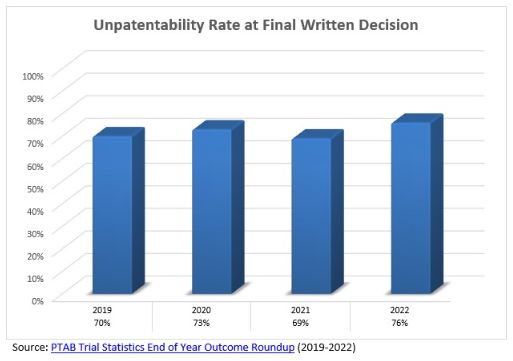- within Coronavirus (COVID-19), Insurance and Accounting and Audit topic(s)
This alert's key takeaways include:
- The Patent Trial & Appeal Board (PTAB) has held unpatentable 70% or higher of the claims that it addressed in a final written decision over the last four years;
- This rate is not comforting for patent owners who if instituted, should explore alternative resolutions to avoid a final written decision; and
- Based on the historical trend and the present climate at the PTAB, which includes climbing institution rates, we expect the high rate of unpatentability at final written decision to continue in 2023.
When you are embroiled in a contentious battle with your competitor in aninter partesreview (IPR) proceeding, what is your ultimate goal? To win, of course. But what are your odds of success? This alert delves into the win rates for both patent owners and patent challengers over the last four years at the PTAB and provides predictions for what to expect in 2023.
Often, legal commentators are too focused on the PTAB's fluctuating institution rate. But once a proceeding is instituted and a trial goes to completion, what ultimately matters is the rate at which the PTAB finds claims unpatentable in a final written decision.
This unpatentability rate can be calculated from the raw data provided by the PTAB in its End of Year Outcome Roundup. We crunched the numbers for you and found a staggering statistic: the PTAB has held unpatentable 70% or higher of the claims it addresses in a final written decision. The following chart shows the PTAB's unpatentability rate at final written decision in each of the last four years.

This means that for every 10 claims the PTAB considers at final written decision, 7 or more will likely be held unpatentable.
Now, analyzing the raw numbers in a slightly different manner on a per patent basis, 60% of patents that have reached a final written decision over the last four years have had every challenged claim held unpatentable. This number was the highest in 2022 at 66%, or 2 out of every 3 patents did not have a single claim at issue be patentable. While on the other side of the spectrum, only 19% of patents over the last four years have escaped a final written decision unscathed.
These are not comforting numbers for patent owners. The critical takeaway for patent owners is that the best way to avoid an unpatentability holding by the PTAB is to avoid an institution in the first place. Patent owners should expend maximum effort to defeat an IPR challenge at the institution stage if at all possible. But if that fails and a petition is instituted, then a patent owner needs to at least reevaluate its position and more heavily consider alternative resolutions to avoid a final written decision.
Consequently, these are attractive numbers for patent challengers. The key takeaway for patent challengers is that if they overcome the hurdle of institution, there is a good chance of achieving an unpatentability holding for the overwhelming majority of the claims at issue. This likely gives the patent challenger significant leverage over the patent owner with respect to any resolution opportunities because a patent owner may be more motivated to settle the dispute after an institution to avoid the PTAB's 70% (or higher) unpatentability rate.
Another trend is apparent from the data. The unpatentability rate remains mostly steady from year to year. Indeed, although the recent unpatentability rate is a bit lower than the historical unpatentability rate from 2011-2019 (77% according to the PTAB), the recent and historical rates are not too far off from one another.
Looking ahead to 2023, what do we predict from the PTAB regarding its unpatentability rate? More of the same. Based on the historical trend and the present climate at the PTAB, which includes climbing institution rates as the rate of discretionary denials decreases, we expect that the PTAB's unpatentability rate will remain in the 70% (or higher) range in 2023. We invite you to contact us to further discuss these trends and how we may be able to help leverage them for your business.
The content of this article is intended to provide a general guide to the subject matter. Specialist advice should be sought about your specific circumstances.


